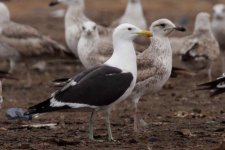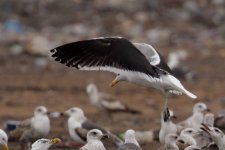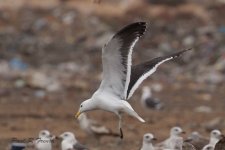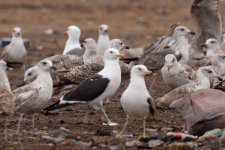Hi everyone,
I am planning a trip to Marocco and reading tons of trips/blogs/articles ecc. I have a couple of points that I cannot solve myself.
The White-Breasted Cormorant (Phalacrocorax lucidus) it is now treated as a separate species from the IOC.
I noticed that is present almost ONLY in the reports from "Limosa Holidays" (correct me if I am wrong).
Why nobody else sees them? (If I understand the issue correctly there is no agreement about them being definitely lucidus...given the possibility of hybridization).
How can I recognise them from the White-NECKED Cormorant?(Phalacrocorax carbo maroccanus)
What criteria does the guide use in his tours?
Second question:
What is the status of the Kelp Gull in south Marocco at the moment? I read the great articles about the discovery of the Great Black Backed Gull (GBBG) colony at khnifiss national parc. And I read many sightings until the latest update of 2 individuals seen few days ago. http://www.magornitho.org/2017/03/kelp-gulls-akhfenir-southern-morocco/
In the cited report there is no mention of GBBGs at all!! Did they disappear? Plus the picture provided in the mention report does not look 100% Kelp to me because of the not completely black back and the not so bulbous beaks (although most features look good).
Is there some article dealing with the the differences, genetic and morphological) between Kelp and GBBG? I found a lot of "outdated" stuff but nothing from the past 2 years. Is there still a colony of GBBGs in south marocco?
Thanks a lot for any help!
And thanks to whoever uploaded material about birds in Marocco, really great stuff out there.
Cheers
piè
PS= I do not want to start a discussion about what is a species. I know is a complicated concept and for my personal definition none of the mention example would be a "good" species. I just want to know which is the current agreement about the mentioned taxon in Marocco since I follow the IOC for my personal list.
I am planning a trip to Marocco and reading tons of trips/blogs/articles ecc. I have a couple of points that I cannot solve myself.
The White-Breasted Cormorant (Phalacrocorax lucidus) it is now treated as a separate species from the IOC.
I noticed that is present almost ONLY in the reports from "Limosa Holidays" (correct me if I am wrong).
Why nobody else sees them? (If I understand the issue correctly there is no agreement about them being definitely lucidus...given the possibility of hybridization).
How can I recognise them from the White-NECKED Cormorant?(Phalacrocorax carbo maroccanus)
What criteria does the guide use in his tours?
Second question:
What is the status of the Kelp Gull in south Marocco at the moment? I read the great articles about the discovery of the Great Black Backed Gull (GBBG) colony at khnifiss national parc. And I read many sightings until the latest update of 2 individuals seen few days ago. http://www.magornitho.org/2017/03/kelp-gulls-akhfenir-southern-morocco/
In the cited report there is no mention of GBBGs at all!! Did they disappear? Plus the picture provided in the mention report does not look 100% Kelp to me because of the not completely black back and the not so bulbous beaks (although most features look good).
Is there some article dealing with the the differences, genetic and morphological) between Kelp and GBBG? I found a lot of "outdated" stuff but nothing from the past 2 years. Is there still a colony of GBBGs in south marocco?
Thanks a lot for any help!
And thanks to whoever uploaded material about birds in Marocco, really great stuff out there.
Cheers
piè
PS= I do not want to start a discussion about what is a species. I know is a complicated concept and for my personal definition none of the mention example would be a "good" species. I just want to know which is the current agreement about the mentioned taxon in Marocco since I follow the IOC for my personal list.










